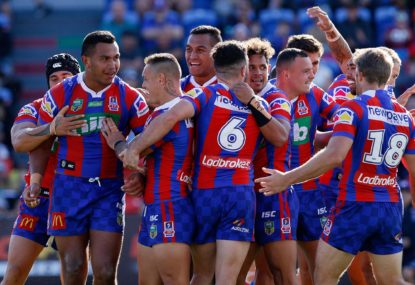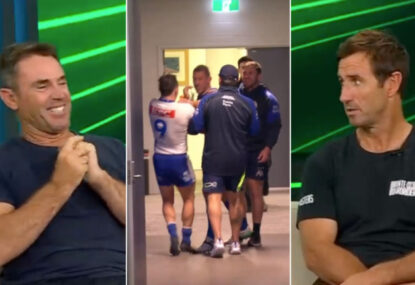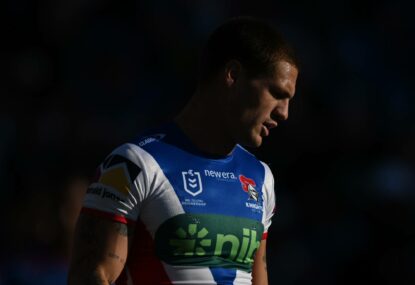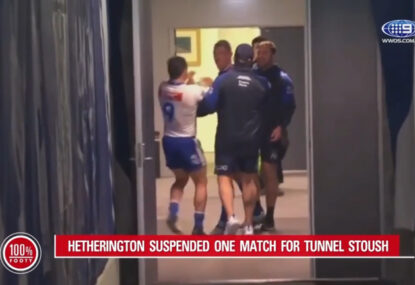Today, I’ll be heading along to watch the Knights take on the Sharks at Beanie for Brain Cancer Stadium – McDonald Jones Homes having donated naming rights for the weekend to the Mark Hughes Foundation.
It’s a wonderful gesture and while the cynic in me sees the obvious upside for McDonald Jones, well, corporate sponsorship of any event is ultimately about making a profit – even if it is in the long term – so if the home building firm ends up earning some coin while helping Hughes in his battle against brain cancer, I say good luck to them.
And good on the NRL for getting behind Hughes’ cause so emphatically. The league’s support saw the foundation raise a whopping $1.75 million in last year’s Beanie for Brain Cancer round, so fingers crossed they crack the $2 million mark this time around.
But before going any further down this path, let’s take a quick detour.
Each November in England, a national discussion tends to spring up regarding football player James McClean.
See, during the weeks leading up to Remembrance Day – November 11 – many UK citizens show their support for troops past and present by wearing a poppy. The poppies in question are generally made of paper – their cheap flimsiness is actually a wonderful piece of design, as it means people tend to buy more than one – with profits going to the Royal British Legion.
The clubs of the English Premier League also wear special Remembrance Day shirts in matches played the weeks before November 11, with a poppy embroidered into the material.
But every year since 2012 – the season he made his EPL breakthrough – McClean has refused to wear one of these shirts.
Having been born and bred in Derry, Northern Ireland – a place that had more than its fair share of heartache during The Troubles – McClean chooses not to wear the poppy as he does not want to support the British Armed Forces.
And every year, McClean cops abuse from both the opposition and his own team’s fans for not showing respect to the troops. He’s even received death threats.
For his part, McClean doesn’t make a song and dance over it, he simply chooses not to show support for a cause he doesn’t believe in – which should be, and is, entirely up to him.
However, in 2015, he wrote a letter to his club’s fans explaining why he chooses not to wear the poppy.
“People say I am being disrespectful but don’t ask why I choose not to wear it,” McClean wrote.
“If the poppy was simply about World War One and Two victims alone, I’d wear it without a problem.
“I would wear it every day of the year if that was the thing but it doesn’t. It stands for all the conflicts that Britain has been involved in. Because of the history where I come from in Derry, I cannot wear something that represents that.”
It was an eloquent explanation, which of course did nothing to quell the annual rage against him.
So why bring this controversial issue up on the weekend people are happily wearing beanies to support the Mark Hughes Foundation? Because perhaps the best point McClean raised in his letter was that people don’t ask him why he chooses not to wear the poppy.
Obviously the fight against brain cancer is a pretty easy issue to whitewash – cancer is bad and therefore all efforts made to battle this insidious disease must be good.
And don’t for a second think I’m suggesting that Beanie for Brain Cancer is anything but a brilliant idea for a wonderful cause.
What I am suggesting is that a lot of people will likely just buy a beanie, wear it on the weekend, then move on with their lives.
While they are entirely entitled to do so, and I’m sure Hughes will be glad of the $20 they spent buying a beanie regardless of whether they did anything else, I encourage anyone who gets behind this movement to do a little more than just hand over your hard-earned.
Ask some questions.
I’ll get the ball rolling and even dish up some answers that I was able to find on the MHF website.
How many people are affected by brain cancer?
“Brain cancer is the leading cause of cancer death in children, and adults aged under 40 in Australia”.
Doesn’t this disease already get mountains of funding?
“Brain cancer receives very little funding, in 2012 received only 3 per cent of federal government funding”.
How much does it cost to treat the disease?
“Brain cancer costs more per patient than any other cancer because of its highly debilitating, affects people in their prime and often means family members cannot work if they become carers”.
Where is my money going?
This is the most important question but also the one people are most hesitant to ask.
Many worry that when giving to charity, such a question may come across as greedy or insensitive, but I daresay Hughes wants everyone to ask this question, because he’s got some damn good answers.
Money raised by MHF has helped create a research fellowship, establish a biobank, and hire a care coordinator to help patients and their families through the entire brain cancer process.
These are your beanie dollars, hard at work, doing good for people in need.
Congratulations to Mark and his foundation for all the fantastic work they’ve done and will continue to do – I’m willing to bet they sell out of beanies again this year.
But since one of the foundation’s aims is to create awareness about brain cancer, if you’ve gone out and bought a beanie, maybe follow up with some light reading on the subject and how your money is set to be spent.
I reckon you’ll get a warm feeling, and it’ll have nothing to do with your headwear.



































































































